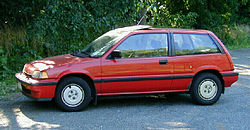 This the car i folling in love..... In Malaysia there call it Honda Dolphin and other name that i cant call it here. The second generation Civic Si shared a chassis with the 2nd generation Honda CRX. The American-market Si sported a 108 hp (81 kW) D16A6 engine and weighed in at 2,286 lb, achieving a factory 0-60 of 8.1 seconds; and a quarter-mile time of 16.2 at 82mph.[5] The main standard features of the Si trim were the power sun roof/moon roof, tachometer, passenger door mirror, color matched bumpers, dash clock, larger exhaust, front and rear anti-roll bars, 14" wheels and sport seats. Additional options were air conditioning and fog lights, as well as the different Honda Genuine Accessory alloy wheels. In Europe and Australia, a more powerful D16A8 engine was used instead, which made 122 hp (91 kW).
This the car i folling in love..... In Malaysia there call it Honda Dolphin and other name that i cant call it here. The second generation Civic Si shared a chassis with the 2nd generation Honda CRX. The American-market Si sported a 108 hp (81 kW) D16A6 engine and weighed in at 2,286 lb, achieving a factory 0-60 of 8.1 seconds; and a quarter-mile time of 16.2 at 82mph.[5] The main standard features of the Si trim were the power sun roof/moon roof, tachometer, passenger door mirror, color matched bumpers, dash clock, larger exhaust, front and rear anti-roll bars, 14" wheels and sport seats. Additional options were air conditioning and fog lights, as well as the different Honda Genuine Accessory alloy wheels. In Europe and Australia, a more powerful D16A8 engine was used instead, which made 122 hp (91 kW).Compared to the previous generation, the Civic Si saw an improvement in handling, in part due to the double-wishbone suspension at all four corners and lower wind drag due to the sleeker body shape.
Initially, the Civic Si hatchback was absent from the line-up, with only the CRX Si offered for the 1988 model year. That changed, however, for 1989, and the Civic Si hatchback was reintroduced, along with a 3-hp upgrade for the D16A6 engine across all Si trims (making 112 hp). As with all other trims, the Civic Si received a slight visual upgrade in 1990, featuring revised bumpers and tail lights.
In the later years of the second generation, the JDM version adopted a 1.6L B16A engine that produced 158 hp (118 kW), and was the first to adopt the name "SiR" instead of Si. With its light weight, independent suspension and powerful engine, the car was well-received globally, receiving “Golden Steering Wheel Award” from the German newspaper Bild am Sonntag, and ranking first in France’s L’Automobile Magazine 1989 survey on car quality and reliability. The European model badged as a "1.6i-VT" used a slightly less powerful B16A1 engine, which had an 8200 RPM redline and made 150 hp (112 kW), although it made the same 111 ft.lbf. of torque as the Japanese market B16.
Along with the introduction of the B-series, the second-generation Si saw the introduction of Honda's variable valve timing and electronic lift control technology, or VTEC. By providing two different camshaft profiles—one for fuel economy, one for performance—the VTEC engines set a high-revving, naturally-aspirated precedent for future performance variants of the Honda Civic.
Due to the difference in engine output and modification potential between the American and JDM models, the second-generation Si sparked a popular trend of engine swapping, where tuners would replace the D-series power plant (whose limiting factor for power were its weak connecting rods) with the stronger B-series motor
from wikipedia

